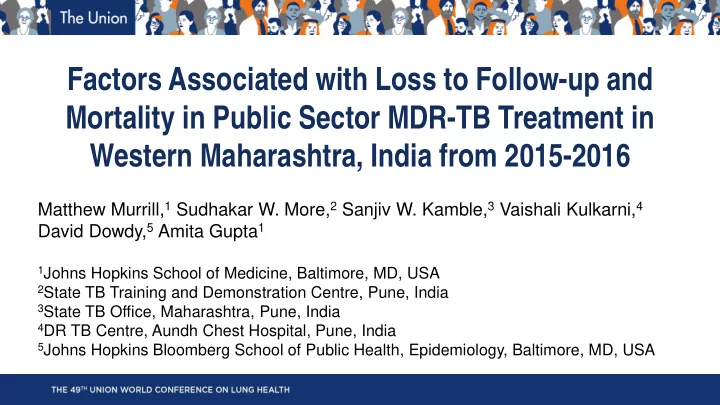

Factors Associated with Loss to Follow-up and Mortality in Public Sector MDR-TB Treatment in Western Maharashtra, India from 2015-2016 Matthew Murrill, 1 Sudhakar W. More, 2 Sanjiv W. Kamble, 3 Vaishali Kulkarni, 4 David Dowdy, 5 Amita Gupta 1 1 Johns Hopkins School of Medicine, Baltimore, MD, USA 2 State TB Training and Demonstration Centre, Pune, India 3 State TB Office, Maharashtra, Pune, India 4 DR TB Centre, Aundh Chest Hospital, Pune, India 5 Johns Hopkins Bloomberg School of Public Health, Epidemiology, Baltimore, MD, USA
Conflict of interest disclosure [X] I have the following conflict of interest(s) to report: [X] Receipt of grants/research supports - NIH Medical Scientist Training Program - UJMT Fogarty Global Health Fellowship [ ] Receipt of honoraria or consultation fees [ ] Participation in a company sponsored speaker’s bureau [ ] Stock shareholder [ ] Spouse/partner [ ] Other
Study Setting: Western Maharashtra
Methodology • Limitations of prior work: (1) specific risk factors absent, (2) composite outcomes, (3) competing risks • Study design: retrospective cohort analysis • Study population: individuals starting MDR TB treatment at Aundh Chest Hospital from 5 districts of Maharashtra between Jan 2015 to Dec 2016 • Outcomes: loss to follow-up ( ≥2 months), death (from any cause) • Risk factors: clinical, demographic, health service, social • Analysis: survival analysis (subdistribution and Cox proportional hazards)
Methodology: Data Sources • Pre-treatment evaluation: medical records DR-TB Centre • Treatment cards (DR TB Centre) • Treatment register (DR TB Centre) • Treatment cards (DTO) District TB Office (DTO) • Treatment register (DTO) • Adjudication with DOTS-Plus Supervisors Tuberculosis Unit (TU) • Treatment cards (TU) Peripheral Health • Treatment cards (DOTS provider) Institution (PHI)
Factors Associated with Loss to Follow-up and Mortality (n = 684)
Conclusions • Primary findings: • Strengths: Leveraged multiple programmatic data sources • • Treatment outcomes similar to • Competing risks survival analysis national averages • Loss to follow-up: alcohol use, • Challenges: prior private treatment • Data sources: • Mortality: undernutrition, anemia Data standardization and integration • • Missing data • Implications: • Outcome status: • Loss to follow-up tracing efforts not done • Highlights potential of leveraging • Transfer out, switch to XDR TB treatment existing public sector data were censored • Need to integrate alcohol • Public sector treatment data only treatment interventions into care
Acknowledgements • Revised National TB Control Programme, Maharashtra • Dr. Sanjiv W Kamble (State TB Office) • Dr. Sudhakar More (STDC, Pune) • Ms. Vaishali Kulkarni (Aundh Chest Hospital) • City TB Officers and DOTS-Plus Supervisors • Johns Hopkins University SOM and SPH • Dr. Amita Gupta • Dr. David Dowdy • Dr. Vidya Mave, Dr. Nishi Suryavanshi • Dr. Nicky Mehtani • Ms. Pallavi Kadam, Mr. Mahesh Madane • Funding and support: NIH Medical Scientist Training Program (JHU), UJMT Fogarty Program
Recommend
More recommend